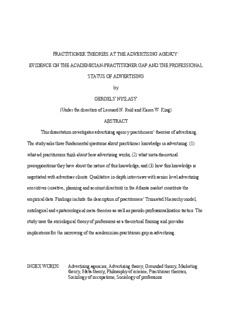
practitioner theories at the advertising agency PDF
Preview practitioner theories at the advertising agency
PRACTITIONER THEORIES AT THE ADVERTISING AGENCY: EVIDENCE ON THE ACADEMICIAN-PRACTITIONER GAP AND THE PROFESSIONAL STATUS OF ADVERTISING by GERGELY NYILASY (Under the direction of Leonard N. Reid and Karen W. King) ABSTRACT This dissertation investigates advertising agency practitioners’ theories of advertising. The study asks three fundamental questions about practitioner knowledge in advertising: (1) what ad practitioners think about how advertising works, (2) what meta-theoretical presuppositions they have about the nature of this knowledge, and (3) how this knowledge is negotiated with advertiser clients. Qualitative in-depth interviews with senior level advertising executives (creative, planning and account directors) in the Atlanta market constitute the empirical data. Findings include the description of practitioners’ Truncated Hierarchy model, ontological and epistemological meta-theories as well as pseudo-professionalization tactics. The study uses the sociological theory of professions as a theoretical framing and provides implications for the narrowing of the academician-practitioner gap in advertising. INDEX WORDS: Advertising agencies, Advertising theory, Grounded theory, Marketing theory, Meta-theory, Philosophy of science, Practitioner theories, Sociology of occupations, Sociology of professions PRACTITIONER THEORIES AT THE ADVERTISING AGENCY: EVIDENCE ON THE ACADEMICIAN-PRACTITIONER GAP AND THE PROFESSIONAL STATUS OF ADVERTISING by GERGELY NYILASY B.A., Pazmany Peter Catholic University, Hungary, 2000 M.MC., The University of Georgia, 2001 A Dissertation Submitted to the Graduate Faculty of The University of Georgia in Partial Fulfillment of the Requirements for the Degree DOCTOR OF PHILOSOPHY ATHENS, GEORGIA 2006 © 2006 Gergely Nyilasy All Rights Reserved PRACTITIONER THEORIES AT THE ADVERTISING AGENCY: EVIDENCE ON THE ACADEMICIAN-PRACTITIONER GAP AND THE PROFESSIONAL STATUS OF ADVERTISING by GERGELY NYILASY Major Professor: Leonard N. Reid Karen W. King Committee: William Finlay Dean M. Krugman Electronic Version Approved: Maureen Grasso Dean of the Graduate School The University of Georgia December 2006 iv DEDICATION To my family: Peter, Ilona, and Zsofi. v ACKNOWLEGEMENTS Many people deserve my deepest thanks and appreciation for assisting the completion of this project. First of all, I would like to thank my chair, Dr. Leonard N. Reid for his relentless support and help, even in the darkest hours, when hurdles seemed impossible to overcome. Thank you for your wisdom, suggestions, leadership and motivation, without which this study would have never been completed. I am grateful that I found a true mentor and friend in you. I would also like to thank my committee members Dr. William Finlay, Dr. Karen W. King, and Dr. Dean M. Krugman for their great suggestions and overall support for this project. Your ideas and direction helped me find much needed focus and avoid mistakes. I would like to express my special gratitude to Dr. Elli Lester Roushanzamir, who has been my intellectual advisor and friend not only during the dissertation project but throughout all my graduate years at Grady. I would also like to thank Dr. Peggy Kreshel for her priceless advice about anything qualitative. I would like to thank all my respondents, members of the Atlanta advertising agency community. Thank you for your generosity in offering your time and ideas. I also thank you for your passion for and devotion to the advertising trade. Without your openness and welcoming spirit, quite literally, this dissertation would not exist today. Thank you Professor Ron Lane and Mr. Richard Riley for helping me find my way around agency offices in the city. vi Finally, my friends and fellow Grady doctoral students deserve my thanks and appreciation for giving much needed intellectual and social support: Michelle, Freddy, Laszlo, Angela, Peter, David, Andras and Barbara, thank you for all your help. vii TABLE OF CONTENTS Page ACKNOWLEDGEMENTS.............................................................................................................v LIST OF FIGURES.........................................................................................................................x CHAPTER 1. INTRODUCTION...............................................................................................................1 The academic-practitioner gap................................................................................2 Purpose and significance.......................................................................................15 Research questions and delimitations...................................................................16 2. LITERATURE REVIEW..................................................................................................19 Direct literature.....................................................................................................20 “Practitioner polls”................................................................................................24 Naturalistic inquiries into advertising practice.....................................................26 The theory of professions – a general theory........................................................32 The theory of professions – in the context of advertising.....................................40 How advertising works – what do we know in academia?...................................48 Summary...............................................................................................................60 3. METHODOLOGY............................................................................................................61 Basic assumptions.................................................................................................61 A grounded theory design – and the role of professionalization theory...............63 Data collection......................................................................................................65 viii Data analysis and the emerging nature of the data...............................................72 4. FINDINGS: CONTENT OF PRACTITIONER THEORIES............................................75 Layers of understanding........................................................................................75 Advertising effects................................................................................................77 Basic and mid-level practitioner theories.............................................................84 Moderator-focused theories..................................................................................92 Domain-specificity..............................................................................................109 Summary and discussion.....................................................................................124 5. FINDINGS: PRACTITIONER META-THEORIES.......................................................131 The only rule: there are no rules.........................................................................132 Ontological skepticism........................................................................................138 Epistemological skepticism................................................................................146 Summary and discussion.....................................................................................161 6. FINDINGS: PRACTITIONER THEORIES AND ADVERTISER CLIENTS: PSEUDO- PROFESSIONALIZATION TACTICS..........................................................................168 Need for certainty...............................................................................................169 Commercial market research as a professionalization agent..............................175 Pseudo-professionalization tactics......................................................................180 Summary and discussion.....................................................................................197 7. CONCLUSION................................................................................................................201 Summary of findings...........................................................................................201 Implications of the research................................................................................205 Research limitations and suggestions for future study.......................................208 ix REFERENCES............................................................................................................................211 APPENDICES.............................................................................................................................229 A INTERVIEW GUIDE......................................................................................................229 B CONSENT FORM...........................................................................................................231 C EXHIBIT OF PRACTITIONER’S AESTHETIC THINKING (FROM PRICKEN 2002)..............................................................................................................232
Description: